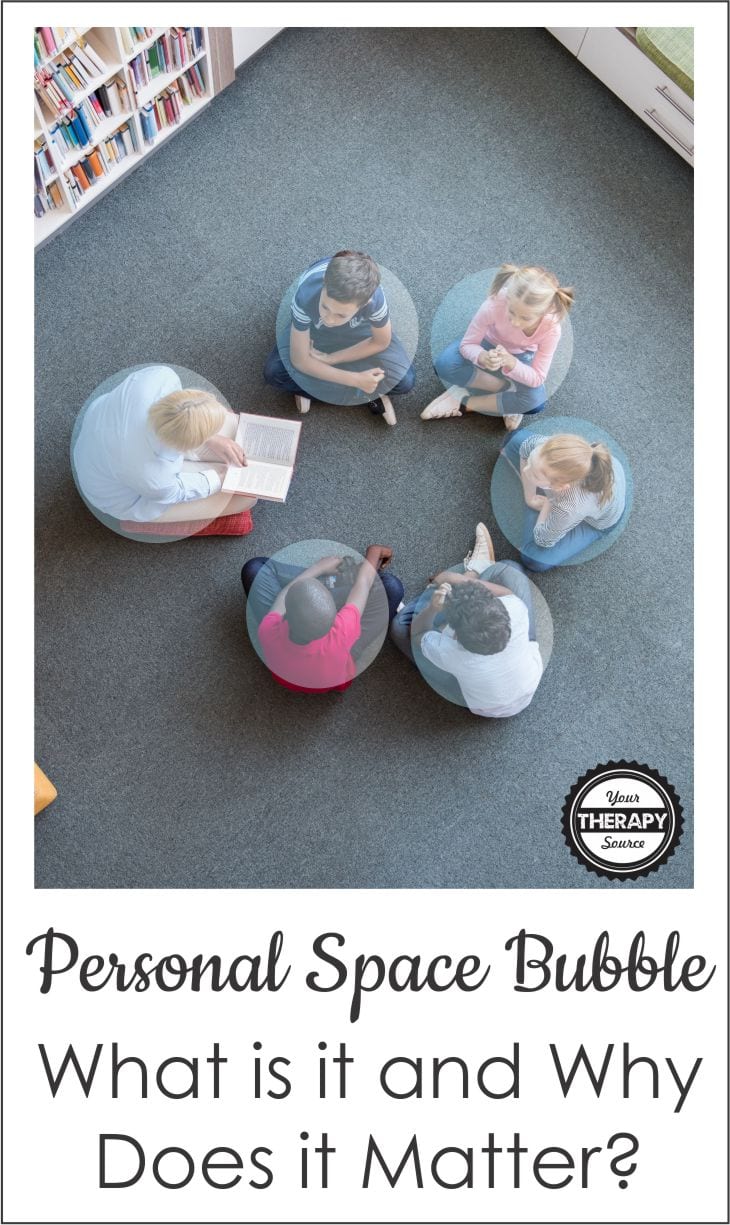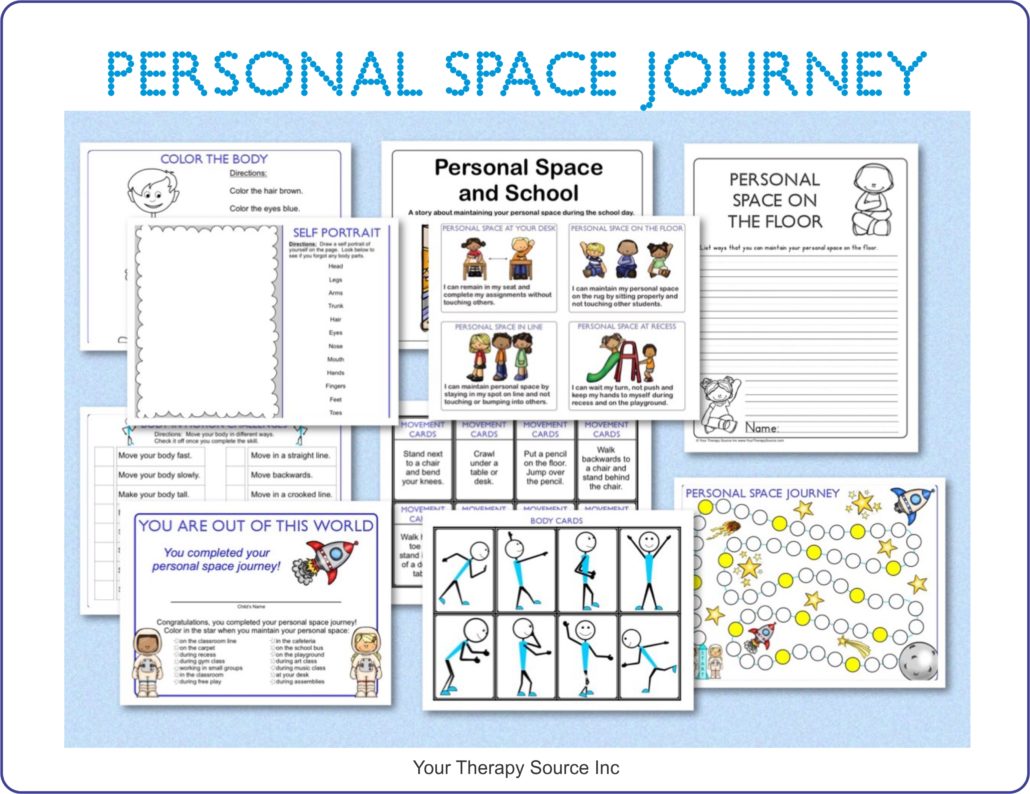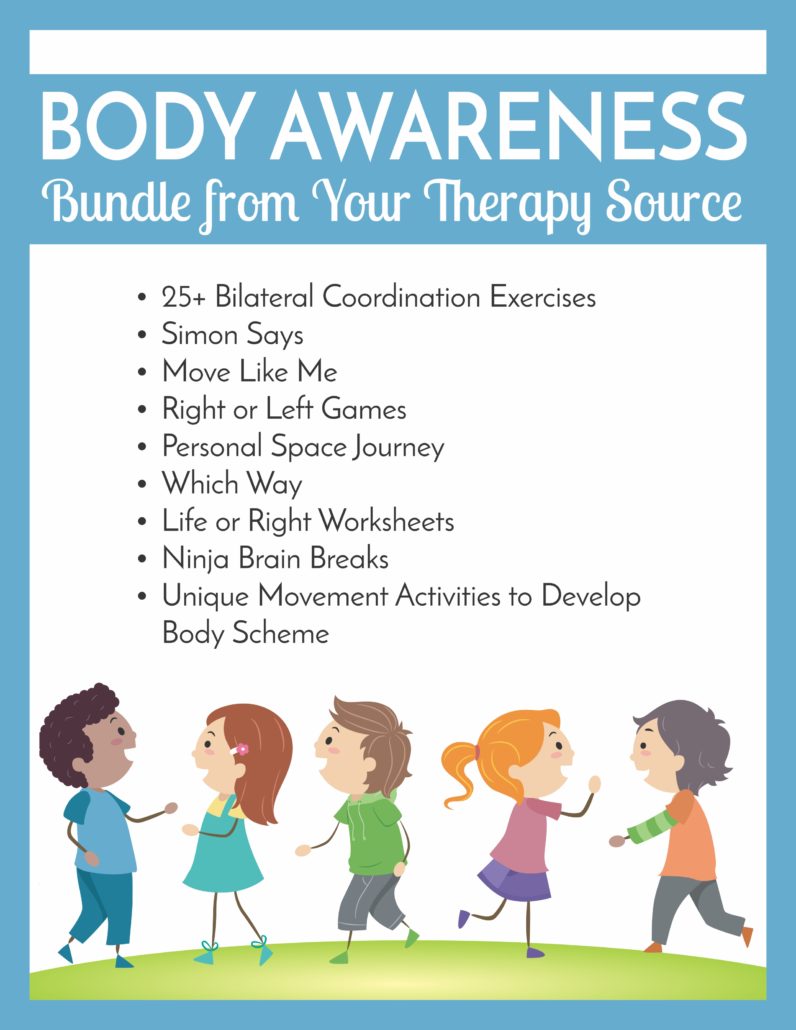Personal Space Bubble – What is it and Why Does it Matter?
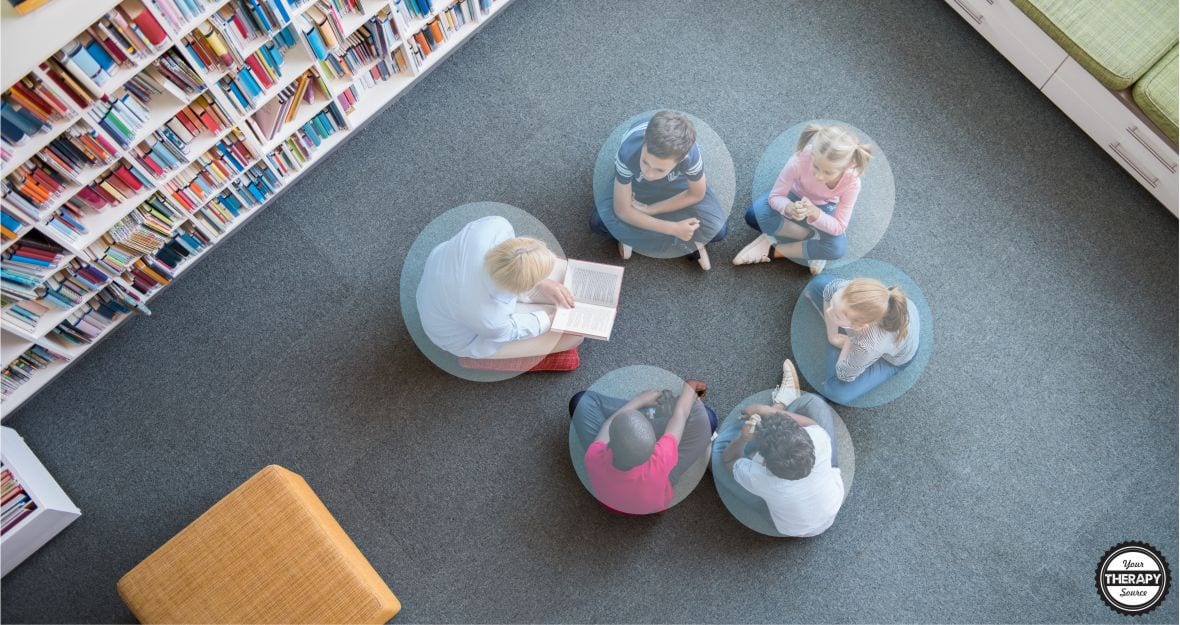
Have you heard the phrase “personal space bubble”? If you work with children or in education, you most likely have heard it being said multiple times. Or perhaps you have seen it action when children are not always the best at respecting someone’s personal space bubble.
A personal space bubble is an imaginary bubble around yourself to represent the comfortable distance between you and other people or objects. Each person has varying comfort levels of personal space bubbles. Some are larger than others.
What Influences Your Personal Space Bubble?
People, places and even things can influence your personal space bubble. For example, most of us are comfortable with a shorter distance between ourselves and family members versus teachers, other adults or even friends. Maybe you feel more comfortable with people in your own home or familiar places versus new situations or locations.
Have you ever been somewhere and an object makes you back up and increase your distance from it? Think to a time when you were at a haunted house and saw something scary. You increase your personal space and move backwards rather quickly to avoid being too close to the scary object.
There is generally considered to be four distinct zones of personal: (1) intimate space (0-18 inches) i.e. for hugging or whispering, (2) personal space (18 inches to 4 feet) i.e.interactions for family and good friends, (3) social space (4 to 10 feet) i.e. interactions between acquaintances, and (4) public space (10 feet+) i.e. public speaking. These distances are dependent upon your culture as well. The zones mentioned here are for the United States.
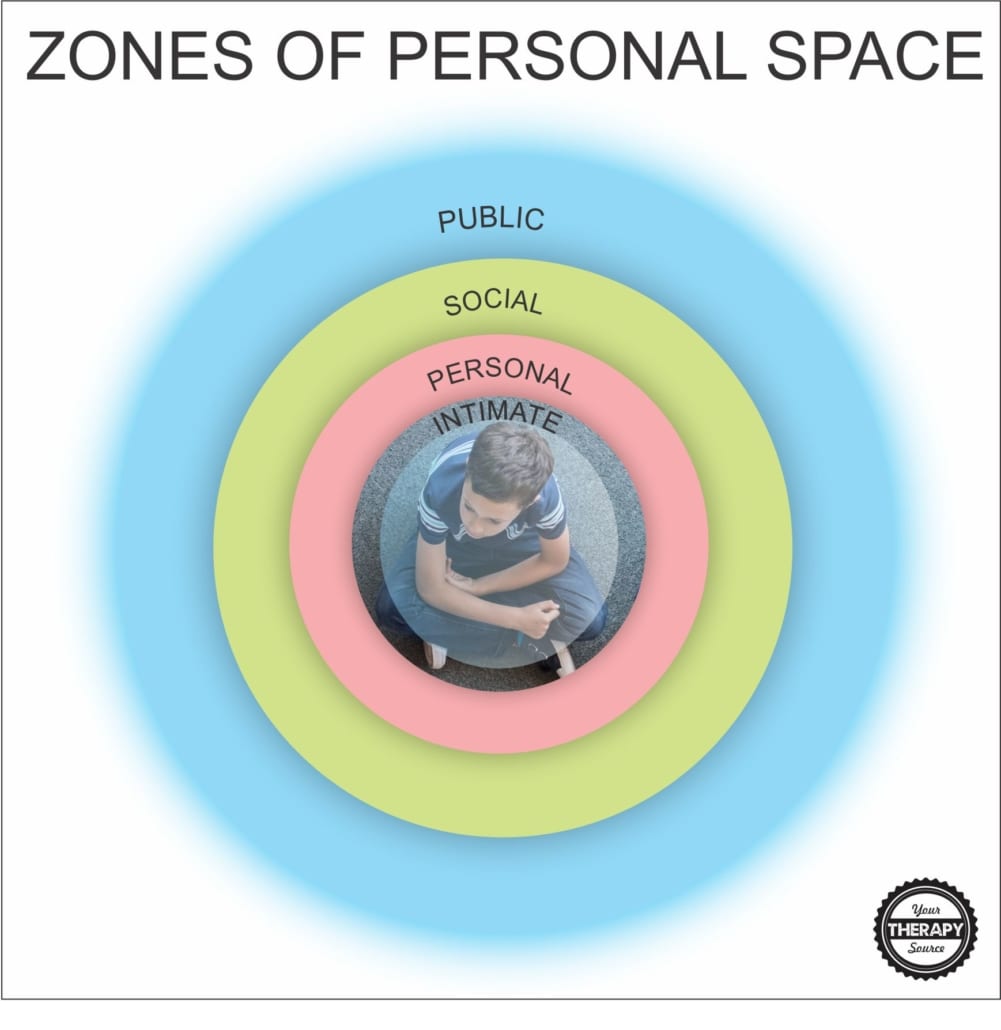 Why Is a Personal Space Bubble Important?
Why Is a Personal Space Bubble Important?
Young children will crawl onto your lap, touch your face or slobber on your shirt with no sense of personal space but as we get older we begin to follow social cues and begin to establish our comfort levels with personal space for ourselves and others. The ability to maintain proper personal space helps to establish effective communication and good interpersonal relations.
Children who present with deficits in proprioception, body awareness and interpreting social cues may have problems with developing their personal space bubble. You may see these deficits present in the classroom when you observe students doing the following:
- not keeping their hands to themselves.
- lack of social skills.
- sitting too close to their classmates.
- bumping into peers.
- talking too close to a person’s face.
- hugging peers who do not want to be hugged or touched.
- standing too close to peers during free time.
- not reading other people’s body language correctly.
These are just some examples of what outcomes can occur when students lack personal space. Just as mentioned before other factors can influence the ability to respect personal space such as location or the environment.
What Can You Do to Help Students With Deficits in Personal Space?
Students can benefit from direct instruction regarding how to respect other people’s personal space. Teach children about the four zones of personal space and role-play different situations so they understand fully the concept of personal space. Work on activities that focus on body awareness in order to increase the students’ ability to understand where our bodies are in space and how our bodies move.
It is critical to establish an overall “picture” of the student’s understanding of personal space. You can use this FREE Personal Space Rubric below to help guide you to determine a baseline and monitor progress. This rubric takes into account different situations to take a closer look at the student’s skill.
Do they lack respect for other’s personal space during free time but not during academic time? Perhaps they have trouble mostly during physical education and recess? Do they have extreme emotional responses when someone does not respect their personal space? By clearly identifying when, where and how the problem occurs can help to determine what interventions to try.
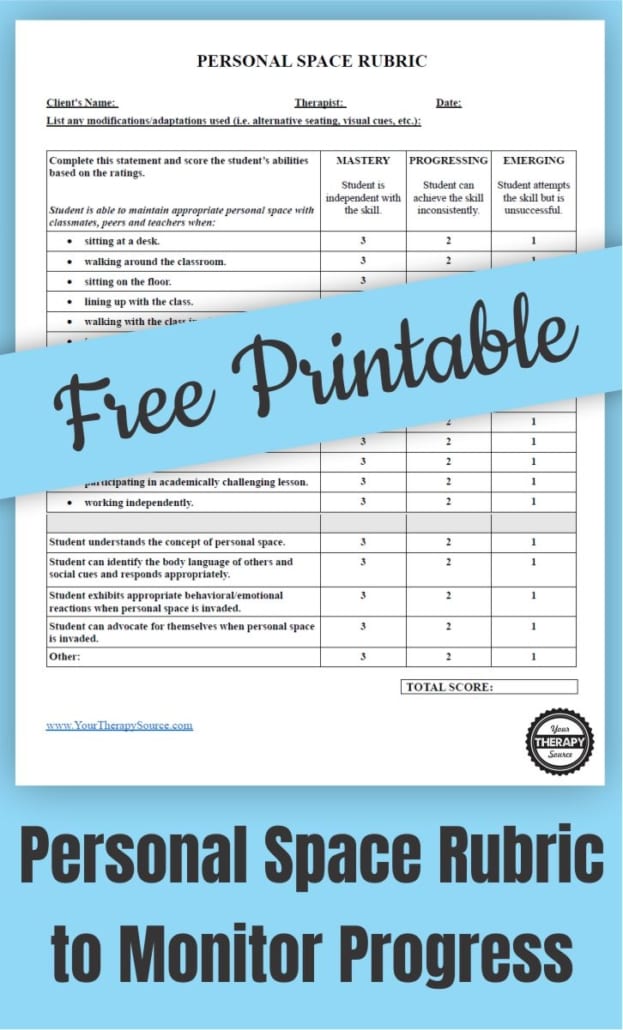
Get your FREE Copy of the Personal Space Rubric
Sign up to receive the weekly email newsletter from Your Therapy Source and other announcements. You will redirected to the one PDF Personal Space Rubric to establish a baseline and monitor progress. If you can not see the sign up box below email [email protected] and reference this freebie.
Possible Interventions to Help Students Learn About Their Personal Space Bubble
Personal Space Journey is a digital collection of activities to teach children about personal space. You can choose how to utilize the materials. Some children may benefit from reading the story first with follow up. Others may need to work on body awareness activities in order to maintain personal space.
- Personal Space Journey Board Game
- 24 Body Cards – the child has to make his/her body look exactly like the body on the card
- 24 Challenge Cards – complete the body awareness and motor planning challenges written on each card
- 16 Movement Cards – complete the movement cards to practice body awareness moving through space
- Body in Motion Challenges Worksheet – try to complete the 16 motor skills moving your body in different ways
- Self Portrait – practice drawing a self portrait and remember to include many body parts
- Color the Body – identify and color in various body parts
- Personal Space Journey Letter for Home – letter written to parents about developing body awareness
- Personal Space and School – a 12 page social story about maintaining personal space in school
- “I Can” Statement Posters to compliment the Personal Space social story – 12 “I Can” posters to hang throughout the school to reinforce the personal space journey
- Twelve Small cards of the “I Can” Statements – provide the child with these small cards to remind them to maintain personal space in different situations – i.e. tape to a desk, slip in a notebook, etc.
- Personal Space Journey Certificate – complete this certificate when child has mastered maintaining personal space
- Handwriting Practice – 8 pages of handwriting practice for the child to list ways to maintain personal space in different situations. Provided in dotted line format, double line format (Handwriting without Tears® style) and regular lined paper.
The Personal Space Journey is part of the Body Awareness Bundle.
Recommended Interventions for Personal Space
The results of a survey of 260 pediatric therapists, teachers, and parents indicated that the following interventions were the most successful to help students learn about personal space:
Alternative seating
Body awareness exercises and activities
Movement breaks throughout the day
Physical cues ie holding hula hoop, adaptive seating, etc.
Proprioceptive input and activities
Recess
Sensory diet
Social stories
Video modeling
Visual cues ie picture symbols, circles, etc.
You can read all the details about this survey here.
References:
Asada, K., Tojo, Y., Osanai, H., Saito, A., Hasegawa, T., & Kumagaya, S. (2016). Reduced personal space in individuals with autism spectrum disorder. PLoS One, 11(1), e0146306.
Griffen, Em. A First Look at Communication Theory. Retrieved from the web on 9/16/19 at https://www.afirstlook.com/docs/proxemic.pdf.
